Toby
was a promising puppy, who grew up to be an American champion (CH Shield
Crest Hurricane). But it wasn't exactly a straight line between promising
puppy and finished dog. Along the way, he went through some pretty sorry-looking
developmental stages. We might have given up on him, but he was one of our
first Shelties and we didn't know any better!
Toby got his first point at 17 months, and then stayed
home for a few years to grow up and fill out. We brought him out again at
three and a half, and he finished his championship pretty quickly, getting
a placement in a large and quality-packed Open Black class at the 1993 ASSA
National on the way. And even after finishing, Toby continued to "bone
up" and fill out in muzzle. He was an even better dog a few years after
he finished.
Toby not only got better with age, he also held his quality.
At over 10 years of age, he remained competitive against much younger dogs
in the breed and group rings. His last Group One was at age 10 and a half.
15 weeks old: The
puppy fuzz is gone, but who cares? There's nothing we'd want to hide. This
is a well-balanced puppy with sufficient neck, correct length of body, a
beautiful topline and very nice head detail -- parallel planes, well-defined
stop, and excellent finish of underjaw. He appears to have decent angulation
front and rear and sufficient bone and substance for his size.
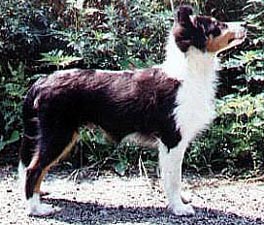 |
Six months old:
This puppy is having some fun on visits to the beach and the pumpkin patch,
but where did the bone and substance go? Does this puppy actually support
himself on those spindly legs? And although he's not standing quite four-square
in the body shot, we still have to ask what happened to the nice topline.
Even if he were standing correctly, it's hard to believe he wouldn't be
high in the rear.
And since neither of these photos shows us much
in the way of head detail, you'll have to take my word for it when I tell
you that the stop and underjaw are pretty much gone at this point, too.
Yikes!
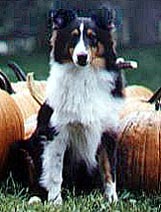 |
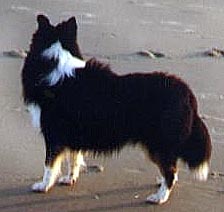 |
11 months old: At
this point, Toby looks "out of balance" and very leggy. And take
a look at the front legs -- even though he's been chalked for a show, this
dog still looks like he's walking around on toothpicks. It might be a passable
amount of bone for a smaller dog, but Toby is not a small dog. The topline
is better than it was (although he's still not standing quite four-square).
Where did the neck go? And what is going on
with that head? Where's the stop? Where's the underjaw? It looked so good
at 15 weeks; could it really be that bad now?
[FOOTNOTE: This photo was taken from
ringside at an all-breed show in late January 1990. I recently ran across
a catalog from that show and was astonished to realize that every
dog in the puppy dog class (6-12 months) at the show that day went on to
finish. How often does that happen? Among the competitors in the puppy class
at that show were future champions Kylene Cindahope Town Cryer, ROM; Macdega
Malibu, ROM; Bare Cove Keep On Tri'N; Shamrock's Cranberry Tiger; and one
or two others that also finished eventually. Talk about tough competition!
Oh, yeah.... and the Open dog got the points that day!]
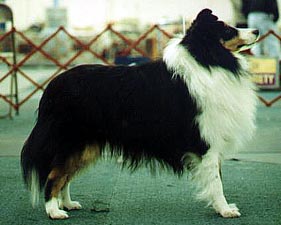 |
13 months old: "Could
the head really be that bad?" we asked while looking at the 11-month
photo. This close-up, taken two months later, pretty much answers THAT question!
(But aren't the first daffodils of spring pretty?)
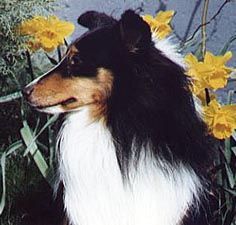 |
17 months old: Toby's
first point. He looks to be in better balance now; even the amount of bone
has improved somewhat. But he is very narrow in front, still very much the
gangly adolescent.
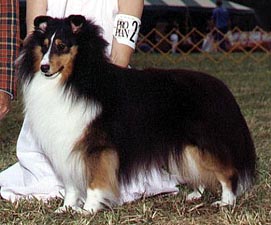 |
Two years old: Half
a year can make a big difference at this age. Comparing this body shot to
the win photo above, we can see how much Toby has "come on" in
the last six or seven months. The bone is better, as is the overall balance.
Even the muzzle has filled out.
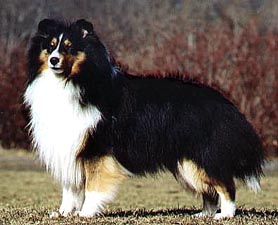 |
Three and a half years old: A win photo taken shortly after Toby's return to the show ring.
Toby is now a well-balanced, masculine dog who is ready to win.
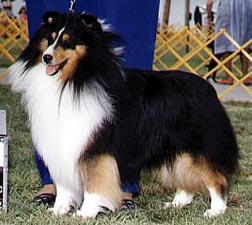 |
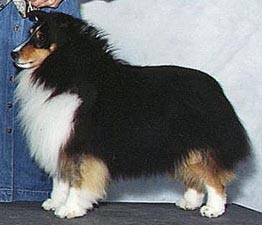
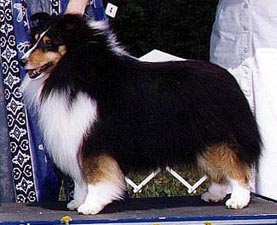 |
Nine and a half years (left) &
almost 10 years (below): Comparing these photos with the one
just above, you can see Toby's further development of bone and muzzle even
after the age of three and a half. Each of these photos of Toby was taken
after a Group One win at an age when most showdogs have been long retired.
Maybe being a slow maturer isn't such a bad thing! |
|








